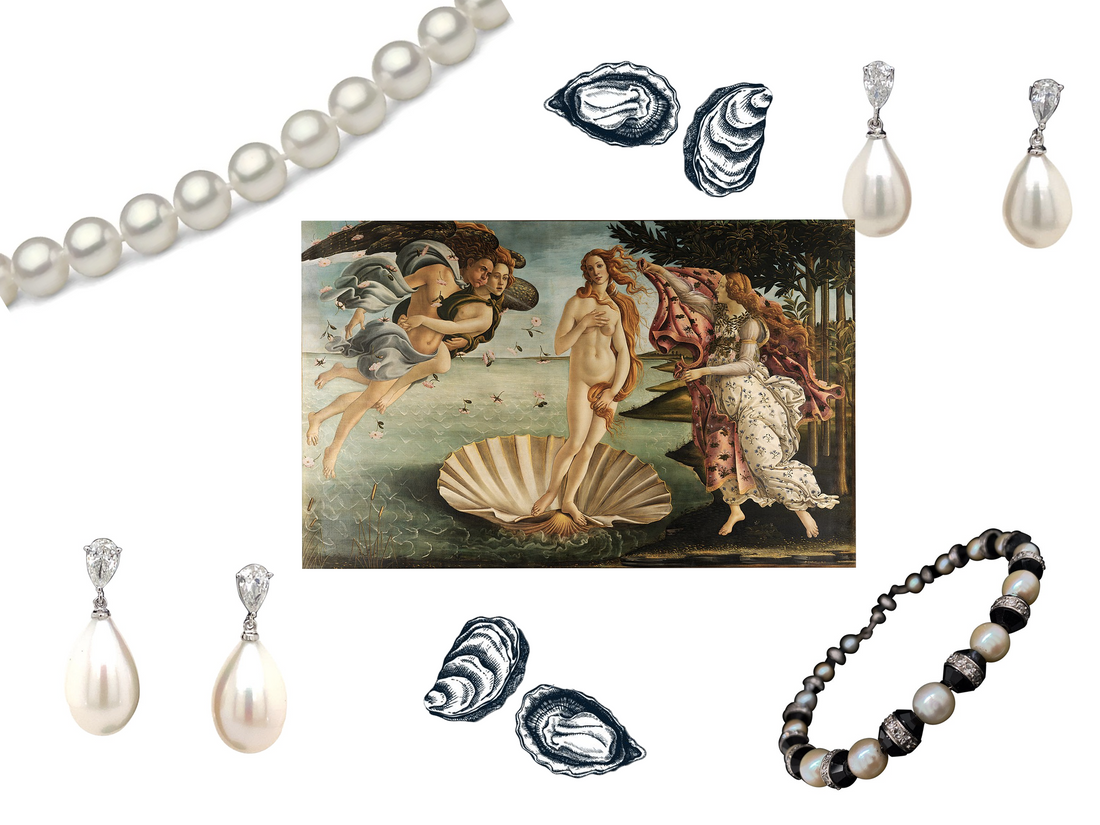Pearls are officially the world’s oldest gem and have been around long before written history. For this reason their discovery cannot be attributed to one person - it is believed they were first discovered by people searching for food along the seashore. Thanks to a fragment of pearl jewellery found in the sarcophagus of Persian princess we know that pearls have been worn as jewellery since 420 BC - this is fragment is now on a display at the Louvre in Paris.
Freshwater pearls are best known for their variety in shape and colour. The character of a freshwater pearl can be told through their distinctive surge and warmth of lustre. The nacre of a freshwater pearl does not have the glossy and metallic finish found in an akoya pearl. These pearls come in a rainbow of natural pastel colours, such as lavender, pink and every shade in-between. Because they offer a wider variety of colours, shapes and sizes than other kind of pearl, freshwater pearls are often used in fanciful jewellery.
Whilst freshwater pearls are, as a variety, the most common type of pearl, very round and lustrous freshwater pearls are hard to find. Top of the line freshwater pearls are rare and highly sought after. They are eye-catching with their rich, bright lustre. Fun fact - A single freshwater pearl mussel is capable of producing up to 50 pearls at a time!
At freshwater pearl farms, each mussel is surgically implanted with 24-32 tiny pieces of mantle tissue, a process known as nucleation. Once the tissue has been inserted, a sac forms and cells begin secreting nacre (pronounced nay-ker) forming a calcium-carbonate compound - a pearl. Over the course of 2-7 years, the mussels deposit layer upon layer of care around the growing gems, generally producing more than two dozen pearls clustered on the inside of each shell. Until the start of the 20th century the only way to collect pearls was to dive depths of 100ft to retrieve the pearl oysters. A dangerous job and one that carried limited success. Freshwater molluscs living in shallow rivers or streams were certainly easier to gather but these pearl beds were often reserved royalty!
Pearls were presented as gifts to Chinese royalty as early as 2300 BC. Pearl jewellery in Ancient China was said to symbolise the purity of the wearer. In Ancient Rome, pearl jewellery was considered the ultimate status symbol. So precious were the gems that in the 1st century BC, Julius Caesar passed a law limiting the wearing of pearls to only the ruling class.
The abundance of natural oyster beds in the Persian Gulf meant that pearls carried great importance in Arab cultures, where legend stated that pearls were formed from dewdrops that were swallowed by oysters when they fell into the sea. Before the time of cultured pearls, the Persian Gulf was the centre of the pearl trade as well as a great source of wealth in the region.
In the Dark Ages, knights would often wear pearls on the battlefield, believing that they would keep the wearer safe. According to legend, Cleopatra crushed a pearl into a glass of wine to prove to Marc Antony that she could give the most expensive dinner in history. Pearls have been an important trade commodity since Roman times, and the discovery of pearls in Central and South America in the 15th/16th century led to the so-called Pearl Age. With the escalating demand for pearls in Western Europe, where ladies of nobility and royalty wore elaborate pearl necklaces, earrings, bracelets and brooches, by the 19th century demand for pearl jewellery became so high that oyster supplies began to plummet!
In terms of fashion trends, pearls have had bumps journey, particularly in the latter half of the 20th century. In the 1920s pearl necklaces were all the rage. Known as sautoirs, these long necklaces would often measure more than 30 inches and be decorate with a tassel as a pendant. “A woman needs ropes and ropes of pearls” said Coco Chanel, who was rarely seen without a pearl of pearls worn around her neck. Somewhere in the 1980s pearls became synonymous with elder ladies and fell out of fashion, however they back and bigger than ever now!
As with all gemstones there is a scale of which you determine your pearls on. This scale includes several criteria , such as lustre, shape, colour and size. An important factor to look out for is the thickness of the nacre, as this determines not only the pearl’s loser but also how long it will last. Pearls require a bit of TLC to ensure they stay looking pristine. Pearl jewellery should always be stored separately from diamonds to ensure the harder stone does not scratch the surface. We recommend putting your pearls into a cloth bag before placing them into your jewellery box. Acidic elements such as perfume can dull a pearls lustre, so never spray directly onto your pearls. Think perfume, then pearls!
We hope you enjoyed these pearls of wisdom - sorry! Had too!




